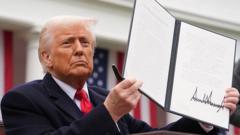Japan has become a pivotal backdrop for President Donald Trump's overhaul of the global trading landscape, as ongoing negotiations culminate in a tentative trade agreement. This development signifies potential benefits for the US under Trump's tough tariff policies, which have long been controversial but are now starting to yield visible outcomes.
Initially, discussions between the US and Japan seemed to progress slowly, despite numerous diplomatic delegations. However, recent talks suggest that Japan, facing a unique economic scenario, may have recognized the inevitability of engaging with Trump's administration and its approach to tariffs. As a result, Japan now holds a relatively favorable position compared to other nations with notable trade surpluses with the US.
The agreement indicates a 15% tariff on Japanese imports, which outstrips the UK's 10% but is moderated by the absence of a trade surplus in the UK. Tension during negotiations was palpable, exemplified by an unexpected outburst from Japan’s finance minister regarding the nation's significant holdings of US Treasury bonds, which could impact negotiations if leveraged correctly.
The US deal with Japan arrives during crucial talks in Tokyo between Japan and EU leaders, showcasing the potential for Japan’s agreement to deter coordinated retaliation from other trade partners like the EU and Canada. As countries like Germany and France consider their own strategies against US firms, the implications of the US-Japan agreement could ripple through international markets.
Moreover, although Japan has successfully safeguarded its agricultural imports, the future of American automobile exports remains unclear. The agreement marks a critical inflection point, as Japan opted for this deal amid rising uncertainties from harsher tariffs slated for implementation on August 1.
Importantly, the revenues generated by tariffs are becoming a significant source of funding for the US Treasury, accounting for approximately 5% of federal revenue this year, with projections hinting at ongoing financial benefits. However, the costs associated with these tariffs fall largely on American consumers, who will likely face increased prices for imported goods.
While the dollar initially strengthened, it has since lost ground, complicating the impacts of tariffs on imports. There’s speculation that the depreciation of the dollar may inadvertently support US manufacturers take advantage of lower currency values, although it complicates trade dynamics further.
As the global trade war continues to unfold, the deal with Japan stands as an early triumph for Trump, perhaps dispelling notions that he usually capitulates under pressure. Nevertheless, the bigger economic picture remains complex, with ongoing vulnerabilities and evolving geopolitical interactions that could influence America's standing in subsequent trade discussions.
Stay updated as these developments unfold in the high-stakes arena of global trade.






















